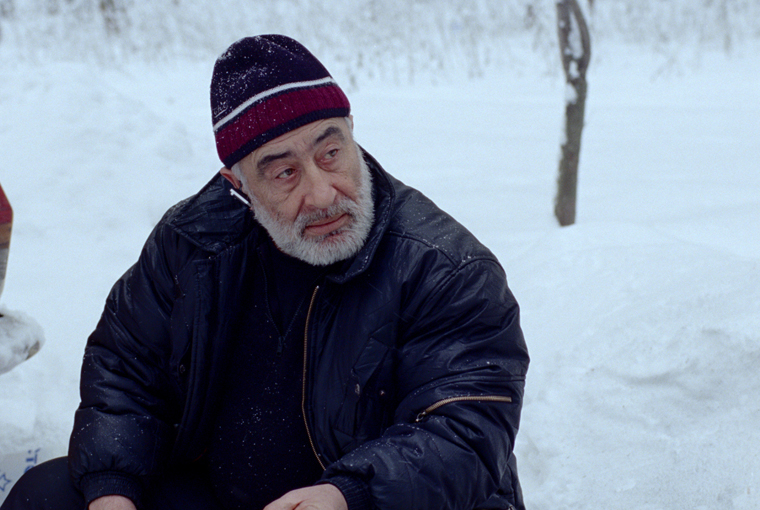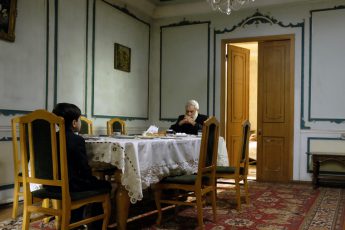Trapped in Eternity
Harutyun Khachatryan’s Endless Escape, Eternal Return (Anverj Pakhust, Haverzh Veradardz, 2013)
Vol. 50 (February 2015) by Julia Zelman
Since we live in the flowing Now, the unity of observed processes is ordinarily only a matter of necessarily inexact recollective thought. Moreover, we never focus, the way a camera can, upon a single process over a long period of time, so that what our retentive capacity gathers for us is, rather than a single given thing observed over a long period of time, only a series of discrete observations pulled out from the multiple contents that have impinged upon our awareness while we were doing and observing other things.”1
As Robert E. Wood points out in the passage above, film differs from normal perception by picking out and emphasizing changes in time that we normally wouldn’t notice in real life. This gives film a twofold, paradoxical ability: to create the illusion of experience preserved from time’s destruction, and to emphasize the passage of time itself. Both processes are at the center of Harutyun Khachatryan’s Endless Escape, Eternal Return, a collage of encounters with the theater director Hayk Alexanyan from the 1980s to 2012.
The film begins and ends in an Armenian cemetery in Moscow, but quickly takes us back in time to meet the younger Hayk in Kamchatka, 1988. There we see an argument between Hayk and his friends who reproach him for having left Armenia to drift in the middle of nowhere. Hayk defends his “escape” from the homeland, saying that the homeland has in fact come with him…and “maybe nature has created us all in a way that we should escape from ourselves.” The camera keeps its distance from him, framing him in a doorway from the next room, so that despite his commanding voice and wide gestures he seems almost trapped or set-upon.
The argument heats up, the extremely animated Hayk gesturing widely, and his visitor growing indignant: “Do you even hunt?” he cries. Cut to a scene in which Hayk and other men, all wearing fur hats and sporting shotguns, ride a tank-like vehicle through a snowy forest and blast rabbits between the trees: a surreal sequence that offsets the proud masculine ritual and the brutality of the animals’ deaths. Echoes of Jean Renoir’s La Règle du jeu are hard to suppress, with their implication of such traditions’ transience on the eve of massive social change.
Animals – and the killing of animals – form a central if mysterious motif in Endless Escape. Fishermen in Kamchatka haul a huge net from the water, slowly dredging up a mass of doomed fish. The scene is silent except for the panicked flapping of the wet bodies. Then an accompanying, faintly sinister, humming music (by Avet Terteryan) – recalling the church scenes bookending the film – links this scene of ritualistic death with the rabbit shooting and with other episodes in Hayk’s life, like a New Year’s party or a picnic in the snow.
If the music evokes death and impermanence, the remarkable stylistic coherence of the film over more than 20 years of shooting seems to defy the passage of time. Hayk himself also seems to grow more imposing: from a near-manic, youthful stage director in Central Asia who discomfits his actors by shouting, scolding, and pantomiming, to a grizzled and massive storyteller miming the story of a family of brown bears, we see a stubborn consistency of personality to the end.
An older man, he at last contemplates returning to Armenia, where “we go to die.” But it is in the Armenian church in Moscow that we last see him, nearly anonymous among the crowd. The film ends on a montage of the snow-buried Armenian cemetery, uniting the themes of homecoming, ritual and death. Hayk has “escaped,” but only up to a point; tradition and remembrance, since they are linked to death, have the power to return and reclaim as long as life remains.
Endless Escape, Eternal Returns distills this paradox, as well as the central self-contradiction of film. It seems to preserve the essence of the extraordinary Hayk while recording the passage of his life. Trapped by time but ever-defiant, Hayk almost embodies the spirit of film itself: by essence, always in motion.




Leave a Comment